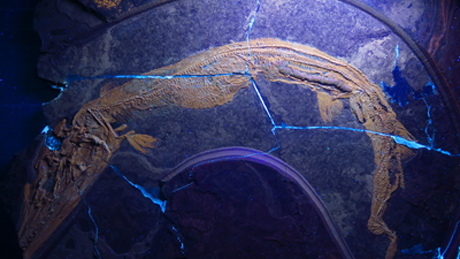Navigation auf uzh.ch
Navigation auf uzh.ch

A last supper has provided some interesting findings. The digested and undigested remains of the last meal eaten by a Saurichthys, a Triassic bony fish, were discovered in a extraordinary case of preservation that paleontologists at the University of Zurich were quick to take advantage of. They used the fossilized gut contents to prepare the first complete documentation on the gastrointestinal anatomy of this primitive vertebrate.
The UZH researchers prepared the fossil, which came from the repository in Monte San Giorgio in Ticino. The preserved gut contents reflect the shape of the gut – as the team under Prof. Marcelo Sánchez was able to see and describe in detail using UV light. To investigate the evolutionary and functional implications of their observations, the researchers assembled a large dataset containing information on extinct and extant fishes. “We also performed statistical analyses that revealed unknown patterns of distribution of the intestinal structure”, explains Marcelo Sánchez. All of this led to the finding that Saurichthys had a straight stomach and a spiral valve.
The findings by the Zurich-based paleontologists unveil previously unexpected convergences with the gastrointestinal anatomy of present-day sharks and rays. “The anatomy of the gastrointestinal tract of Saurichthys, in particular the many windings in the spiral valve, show the most original digestion organs of earlier fishes”, says Thodoris Argyriou, a PhD student at the Paleontological Institute and Museum of the University of Zurich. The spiral valve of Saurichthys indicates an energy-laden lifestyle that was adjusted to the predatory and reproductive behavior of the genus. “The large number of windings increased the surface area for digestion, which is sure to have provided the fish with more energy”, says Thodoris Argyriou.
Thodoris Argyriou, Marcus Clauss, Erin E. Maxwell, Heinz Furrer, and Marcelo R. Sánchez-Villagra. Exceptional preservation reveals gastrointestinal anatomy and evolution in early actinopterygian fishes. Scientific Reports. January 6, 2016. Doi: 10.1038/srep18758